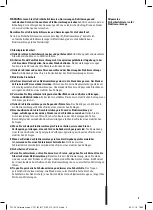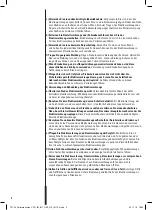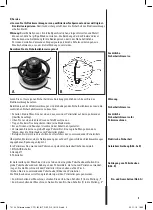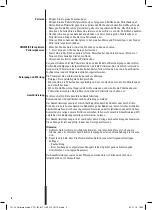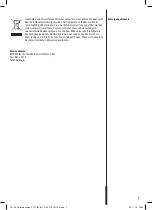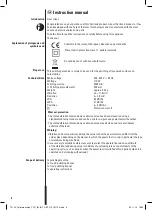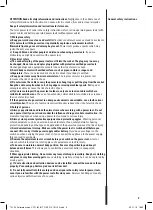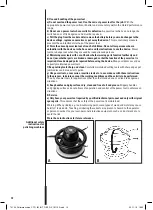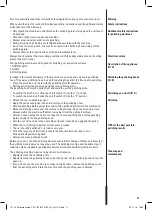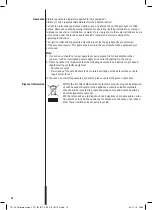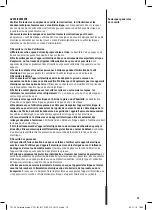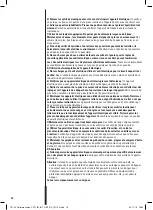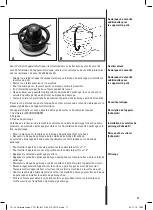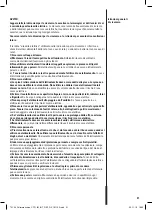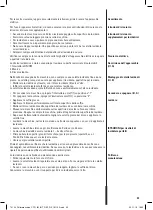
9
General safety instructions
ATTENTION Read all safety information and instructions.
Negligence in the adherence of
safety information and instructions can cause electric shocks, fires and/or severe injuries.
Keep all safety information and instructions for future use.
The term ‘power tool’ used in the safety instructions refers to line-operated power tools (with
power cable) and battery-operated power tools (without power cable).
1) Workplace safety
a) Keep your work area clean and well-lit.
Disorder or unlit work areas can lead to accidents.
b) Do not work with the power tool in potentially explosive environments in which
flammable liquids, gases or dust may be present.
Power tools produce sparks which may
ignite the dust or vapours.
c) Keep children and other people at a distance when using power tools.
If you are
distracted you might lose control of the power tool.
2) Electrical safety
a) The connector plug of the power tool must fit into the socket. The plug may in no way
be changed. Do not use an adapter plug together with protective earthed power tools.
Unchanged plugs and appropriate sockets reduce the risk of electric shock.
b) Avoid body contact with earthed surfaces such as pipes, radiators, ranges and
refrigerators.
There is an elevated risk of electric shock if your body is earthed.
c) Keep power tools away from rain or moisture.
The ingress of water in a power tool
increases the risk of electric shock.
d) Do not misuse the cable to carry the power tool, hang it up or pull the plug from the socket.
Keep the cable away from heat, oil, sharp edges or moving machinery parts. D
amaged or
entangled cables increase the risk of electric shock.
e) If you are working with a power tool outdoors, only use extension cables which are
suitable for outside areas.
The use of an extension cable suitable for outside areas reduces
the risk of electric shock.
f) If the operation of a power tool in a damp environment is unavoidable, use a fault-current
circuit breaker.
The use of a fault-current circuit breaker reduces the risk of electric shock.
3) Safety of persons
a) Always pay attention and take the utmost care when working with a power tool. Do not
use a power tool if you are tired or under the influence of drugs, alcohol or medication.
One
moment of negligence when using a power tool can lead to serious injury.
b) Always wear personal protective equipment and protective goggles.
Wearing personal
safety equipment, such as a dust mask, non-skid safety shoes, safety helmet or hearing
protection, depending on the type and application of the power tool, reduces the risk of injury.
c) Avoid unintentional start-up. Make sure that the power tool is switched off before you
connect, lift or carry it to the power supply and/or battery.
If you have your finger on the
switch on when carrying the power tool, or if you connect the appliance to the power supply,
this can lead to accidents.
d) Remove the adjustment tool or wrench before you switch on the power tool.
A tool or
wrench which is located in a rotating piece of equipment can lead to injury.
e) Take care to maintain a normal body position. Ensure safe positioning and keep it
balanced at all times.
This allows you to control the power tool better in unexpected
situations.
f) Wear appropriate clothing. Do not wear any loose clothing or jewellery. Keep hair, clothing
and gloves away from moving parts.
Loose clothing, jewellery or long hair can be captured by
moving parts.
g) If dust extraction and collection devices can be installed, connect them and use them
properly. Vacuuming up dust may reduce risks from dust.
h) Do not lull yourself into false safety and do not ignore the safety rules for power tools,
even if you are familiar with the power tool after many uses.
Careless handling can lead to
serious injuries within fractions of a second.
72134_Poliermaschine_CTR_IM_INT_OEF_RZ_191125.indd 9
72134_Poliermaschine_CTR_IM_INT_OEF_RZ_191125.indd 9
25.11.19 18:02
25.11.19 18:02



